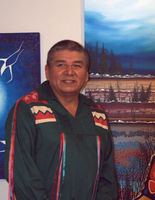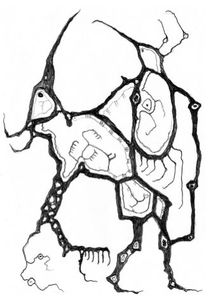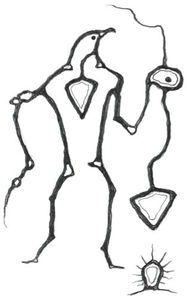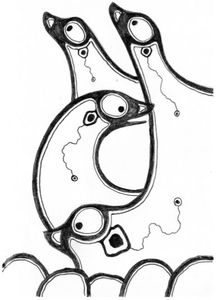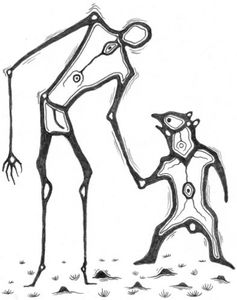Artist James Simon Mishibinijima's Visual Storytelling
There are many ways to tell a story. In his moving collection Pictographs (Porcupine's Quill), Ojibway artist James Simon Mishibinijima explores visual narratives, taking stories he heard from generations of Elders and translating them into the titular images. Arresting, elegant, and powerful, the pictographs approach storytelling in an entirely new way to draw readers into a world of spirits, animals, lessons, and knowledge. A silent exploration of interconnectedness and history, the collection speaks volumes.
We're thrilled to have Mishibinijima on Open Book today. We got the opportunity to get to know him more deeply through our version of the famous Proust Questionnaire. He tells us about his dream of harmony on the boat that is Earth, the artist and neighbour who inspired him as a child, and his motto for life that is a perfect fit for our all too hectic world.
We're also extremely excited to present several of Mishibinijima's original pictographs from the book here today, courtesy of Mishibinijima and Porcupine's Quill.
What is your dream of happiness?
To see everyone live under one roof would be happiness for me because we're all on one boat—the planet Earth. Mankind should reside as one people, and understand that we are one species and need to get along. And when will it happen? When neighbours help neighbours to live.
What is your chief characteristic?
Knowing my place and where I belong. You see, growing up in a family of twelve, we all had a job to do. Most weeks my father stayed at the lumber camps so my mother was the single ruler in the household. I was in charge of wood and water, making sure that we were fully stocked—especially the winter months, as there was no electricity in the house. Those days are fondly remembered from time to time in the quiet of my art studio.
Serpent Spirits
What do you value most about your friends?
Truthful conversations.
What is your favourite occupation?
Creating my Mishmountain signature series of paintings. The series is my greatest accomplishment, and I feel the joy of that accomplishment each time a painting is done.
What is your favourite flower?
Sage. During the annual sacred plant harvest back in the day, my mother taught me the properties of plants used in the sacred smudge. The sage plant was the first plant we came across in the bush lands of Wikwemikong.
Animal Teachers of Survival
Your CanLit News
Subscribe to Open Book’s newsletter to get local book events, literary content, writing tips, and more in your inbox
What is your favourite bird?
The eagle. Born of a woman who is Ojibwe Adawa Potawatomi of Manitoulin Island (better known as the Three Fire Confederacy), my mother was of the Eagle Clan, one of the seven clans of the Ojibwe People.
Who’s your favourite painter?
Wikwemikong pioneer artist Mr. Francis Kagige. He was a neighbour of ours and lived next door. I often made my way to visit Francis after school, upstairs in their whitewashed log house and studio. Francis shared stories about Ojibwe culture.
Who’s your favourite musician?
Native elder and Hollywood actor Mr. Floyd Redcrow Westerman. I once played guitar with Floyd and shared a teaching: Speak the truth and always believe everything you do.
Dawn of the Final Warning
What is it you most dislike?
Gossip filled with lies and disrespect towards others. It is a sphere I don’t want to enter. To listen to and look at these people poisons the energy of others.
What is your current state of mind?
Peaceful.
Inner Spirit
What do you consider your greatest accomplishment?
Being alive at sixty-three and still doing what I do. Loving it!
What is your motto?
Take it slow.
____________________________________________
James Simon Mishibinijima, one of Canada’s foremost Native artists, has created a unique body of work over the past four decades which has attracted a loyal following in North America and overseas. He was born in 1954 in Wikwemikong, Manitoulin Island, where he grew up immersed in the legends of the Ojibway people.
From the 1970s to the present, Mishibinijima has explored many of the sacred places around Manitoulin Island and originated the coveted Mishmountain series, among others. His uplifting philosophy has found resonance with those who seek solace in the midst of tragedy, and meaning in a world that is often confusing and frightening.
In his work he underscores the wisdom of the Elders’ teachings as a way to foster respect and peace. He also emphasizes the interconnectedness of all life and calls upon nations to preserve our natural surroundings for the benefit of our children.
